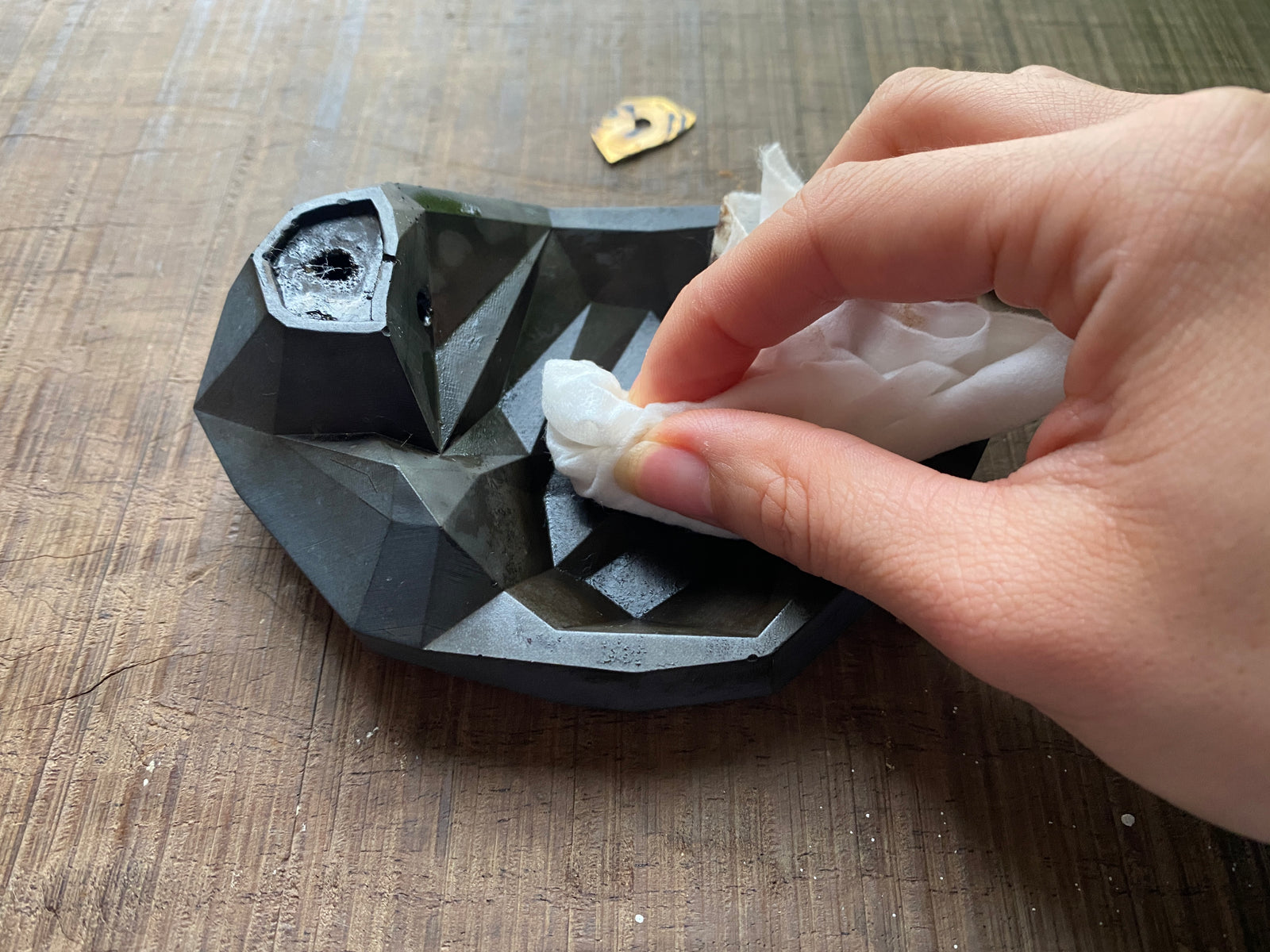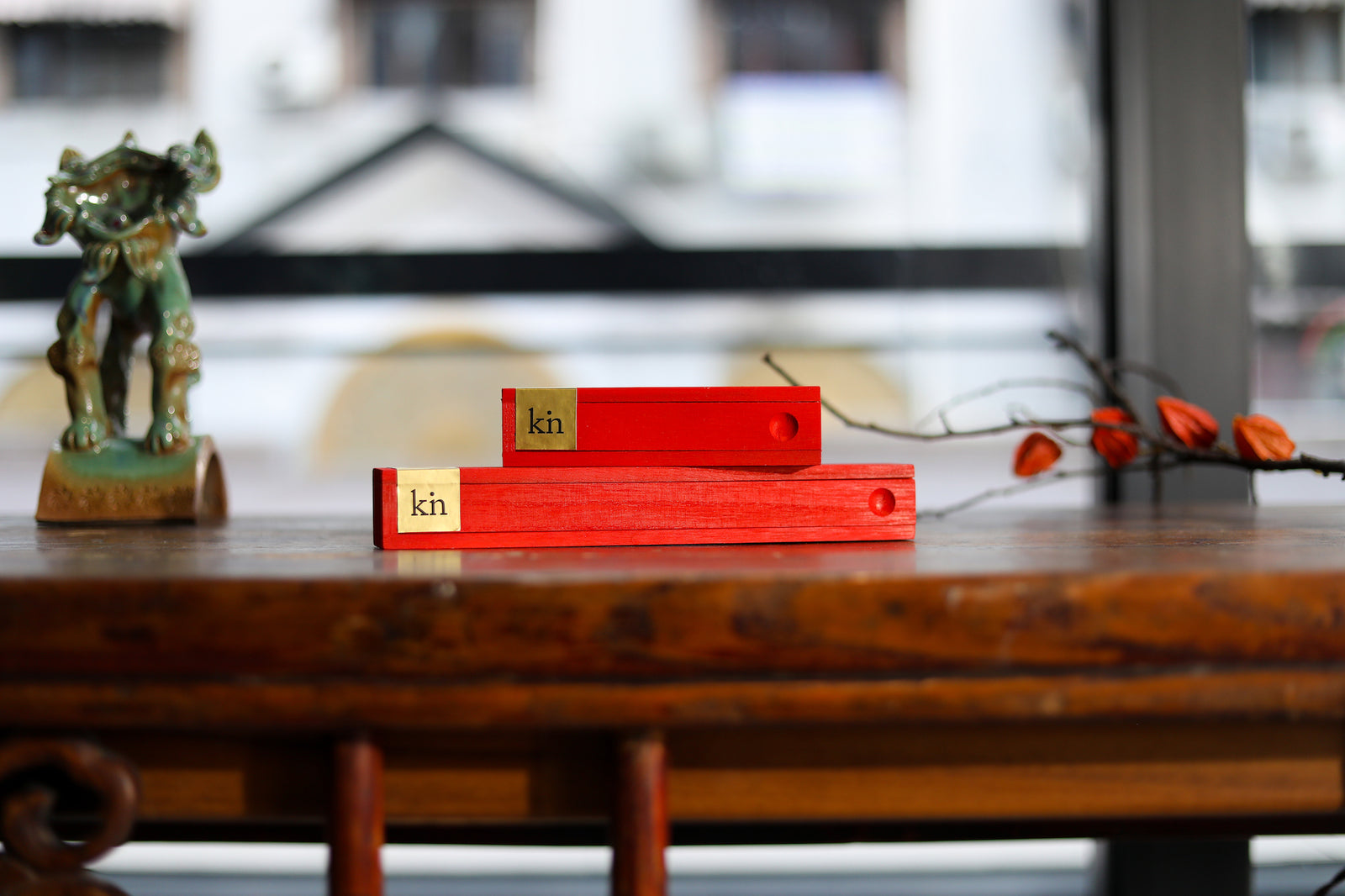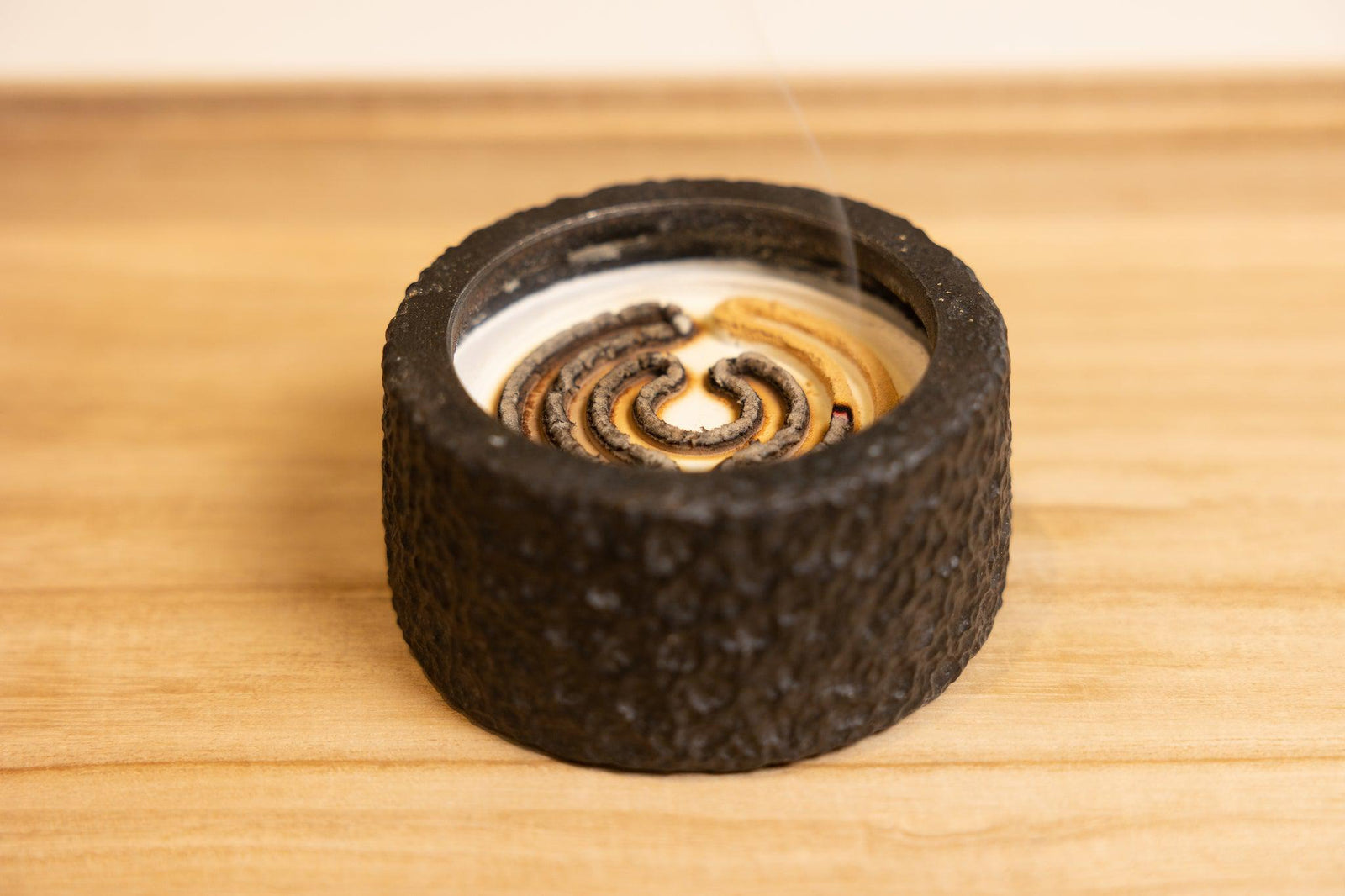If you’ve ever used a backflow incense burner (also known as incense waterfall, waterfall incense burner or incense fountain), you’ll notice that the incense cone leaves behind some oil residue after burning. In fact, we often get customers who contact us with questions about this residue: is this normal? Where does it come from? How do I clean the backflow incense residue?
An unavoidable part of burning incense cones is the oil residue the cone leaves behind, whether it be standard incense cones or waterfall/backflow incense cones. In fact, I often test preliminary blends for our handmade incense collection by simply mixing plant powders together and shaping it into a loose cone for burning, and incense powder burnt in this way also leaves behind the same oily residue.
So I want to make this point very clear: it’s absolutely not some suspicious goo left behind by chemicals or artificial ingredients, it is a very natural part of plant matter.
What is backflow incense residue, and why do incense cones leave this oil behind?

The oily or resinous residue left behind by incense cones is completely normal. It is simply the oil from the plant matter used in the incense. All woods, leaves, flowers and seeds contain oils, and it is in fact the oil that is fragrant (that is why we have essential oils – the aromatic oils obtained from plants). In fact, aloeswood or agarwood (also known as oud in the middle east or jinko in Japan) – the most prized type of incense wood in the world over – often gets more expensive as the oil content of the wood gets higher.
So why do we usually not observe this with incense sticks? Incense cones are much heavier than incense sticks. By our own measurements, incense cones are typically 3-5 times the weight of a typical Chinese or Japanese style incense stick (ie the type of incense stick made entirely out of incense and binding powder, with no bamboo center). So the amount of plant powder used in an incense cone is much more than what is used in an incense stick.
While a small amount of oil from an incense stick (which usually weighs 0.2-0.4g, 1/10 oz or less) may not be easily observable, 3 or 5 times the amount of that oil does become noticeable. And that is what happens when an incense cone is burnt.
Should I clean my incense holder?
Cone incense burners, and in particular incense waterfalls or backflow incense burners, do need to be cleaned. This is because if a large quantity of oil or resin builds up on the plate which holds the incense, it can prevent new incense cones from burning properly. If the hole below the incense cone is blocked up, it will also prevent the smoke from drifting downwards, and you would not be able to see the visual effect intended by the burner.
We recommend that you clean your backflow incense burner once every 2-3 uses, as this ensures only a minimal amount of oil build up, and the burner is therefore relatively easy to clean. BUT – and this is a big BUT, if you have a concrete backflow incense burner from our collection, there is absolutely no need to be fastidious about the cleanliness of your burner. In fact, some oil residue left behind gives the concrete a very nice patina, and adds to its character. I really love its look, and think it looks much better than new burners. I will show you both how this looks like and how to achieve it in this article below.
The first step: how to clean incense ash from a burner with no mess?
You might have followed our instructions on how to burn a backflow incense cone, and now wonder how to clean it all up.
Before we get to the cleaning itself, the first step in cleaning any incense burner is to dispose of the incense ash from the incense cone that has finished burning. This can be tricky, as the burnt incense cone will usually stay in its initial shape, but if you try to pick up the incense-shaped ash, the ash will fall everywhere and that becomes very difficult to clean. So here is our suggested method below. There is another method that involves using a vacuum to suck the cone ash up, but almost 100% of the time we use the method below.
- After the incense finishes burning, wait for the incense and incense holder to cool down for a few minutes. This may vary depending on the holder, so please gently tap the parts you will be handling with the pad of your finger to ensure it is no longer hot before handling it
- Bring a small trash can or plate next to your incense holder. If possible, pick up the piece holding the incense; if not, pick up the entire incense holder
- Tip the piece with the incense on it, or the entire incense burner in one quick movement so the incense falls into the trash
Our favorite way to clean a backflow incense burner in 5 minutes – easy, effective and lifts stubborn residue
This is my preferred way to clean incense holders, it’s simple and very effective. It is efficient, as it makes use of the natural warmth left behind from the burning cone, and it is gentle on the incense burner. Best of all, it can lift some pretty stubborn residue.
I’ll demonstrate the method with the backflow incense burner I have sitting on the window next to my desk at home. It’s probably been about 3-4 burns since I last cleaned it, so there is definitely some resin buildup.

1. After you finish burning an incense cone, wait for the incense ash and burner to cool, until it is a little warmer than room temperature. The best way is to observe the oily residue, it should still be a little runny and not completely solid (see photo below). Please do not handle immediately after burning when the incense burner is still very hot, wait for at least a few minutes and use common sense judgement. Dispose of the incense ash according to instructions above

2. Start the cleaning at the area with the most incense oil buildup, usually close to where the incense cone sits. Remove the piece for holding the incense cone if it is detachable so you can clean the area underneath it. Use a wet cotton bud to clean around this area so you can get into the holes.
I have found that if I don’t clean where my incense cones sit once every few uses, new incense cones will not burn all the way to the bottom. I think this is because oxygen is not getting to the incense properly near the bottom of the incense, preventing the combustion process from completely happening.

3. Use a wet wipe or damp cloth to wipe down the rest of the incense waterfall firmly

4. If the piece holding the incense is metal, and you want to clean it further after wiping it down, you can most likely wash this piece using some warm water, dish detergent and a soft brush. I personally find that wiping gets rid of all the residue that matter (ie, any residue blocking holes that causes the incense burner to not function properly) so I rarely do this

5. Allow the entire backflow incense burner to air dry
6. If necessary, repeat this process. No hurry though, you can simply wait until you next decide to burn an incense cone to do this
Here is a photo of the same backflow incense holder after cleaning once using the method above. I think it’s looking good, with all the major residue gone.

I know some of you must be thinking it’s not back to what it looked like straight out of the packaging... but it doesn’t need to, because here comes the best part. Let's light up another incense cone.


Here is the incense waterfall, post-cleaning and after burning another incense cone. This is just such a great look and finish. The light layer of oil from the new incense cone has settled all over the area that was cleaned, and look at that patina. I think it’s much better than the brand new concrete straight out of the box. Like white sneakers a few months in. So much more character. And the best thing is, every concrete incense burner will have its own unique patina. The incense burner we used here is our Mountain & lake concrete incense burner, you can check out our uniquely designed backflow incense burner collection here for this particular style and other concrete options.
At this point, you can repeat the process above to clean it again, but I rarely do, I just love it looking like this for a couple of burns.
Alternative approach to cleaning waterfall incense burner - alcohol
These are alternative methods that we recommend with some hesitation, because they may cause damage to your incense burner depending on the materials used. However, if your incense burner isn’t made from concrete, and you want to get it even cleaner than the previous method, you can try the below.
The first method is to use rubbing alcohol. Rubbing alcohol dissolves oil so it is quite effective in cleaning up oil-based stains, however alcohol can also strip the top layer from your waterfall incense burner, so please beware of this. We suggest using common household 70% isopropyl alcohol (the type we used through the pandemic for disinfecting hands) and that you start with a small amount to patch test:
- Spray or pour onto a wet wipe or cloth, wipe down an inconspicuous area of the incense burner and wait for it to dry. Once dried, examine the area to see if the top layer has been damaged. If there is damage, we do not recommend you proceeding with this method
- If there is no damage, use a wet wipe or cloth with alcohol to wipe down areas with oily residue that you could not clean with the method above
- Allow the alcohol to dry, and repeat if necessary. We suggest you patch test repeated wiping if you plan to do this, as sometimes the top layer may show no damage after wiping with alcohol once, but will show damage after wiping multiple times
Alternative approach to cleaning waterfall incense burner – water and dish detergent
The second method is to wash the backflow incense burner with warm water and dish detergent. Dish detergent is also very effective at stripping oils from surfaces, but again we are hesitant about recommending this method as being washed with water is not suitable for every material, and if there is any glue used in your incense burner, water and detergent may dissolve the glue or cause loss of strength.
- Mix some warm water with dish detergent in a bowl and choose a tool for washing. We like to start with the gentlest tool which is wet wipes, cloth or non-abrasive sponge, you can also try a soft toothbrush which is likely to be fine for most materials. Avoid using aggressive scrubbing materials
- Patch test an inconspicuous area of the incense burner with the water, detergent and the washing tool you want to use. Once dried, examine the area to see if the top layer has been damaged. If there is damage, try a gentler scrubbing tool, or if you’re already using just a cloth, do not proceed with this method
- If there's no damage, wet your washing tool with warm water and detergent, use this to wipe and gently scrub areas with oily residue
- Use a separate wet wipe or cloth soaked with clean water to clean off the soap, you may need to do this a couple of times like you would when washing anything else with soap
- Allow the water to dry, and repeat if necessary
We’ve seen many instructions online that advise you to soak the entire incense burner in water for 30-60 minutes. Unless you are absolutely sure that your incense burner is made from materials designed to be soaked for this long (eg, a completely ceramic burner), we are quite hesitant about this method.
We hope this article has been useful for you. If you have any questions or suggestions, please feel free to leave them below -






Miranda
June 14, 2024
Hi Gene,
I have not personally cleaned one of these myself, but I would guess that the process is relatively similar. I would say you should wipe it down while there is a remnant of warmth still, because that’s when it’s easiest to remove the oil build up. Depending on what material your burner is, you might be able to use alcohol or detergent. The main difference would be that the build up from directly burning resin would be even quicker than incense cones, so you’d want to clean the burner more regularly (probably after every burn).
Hope this helps!